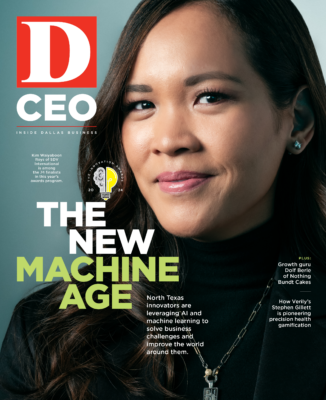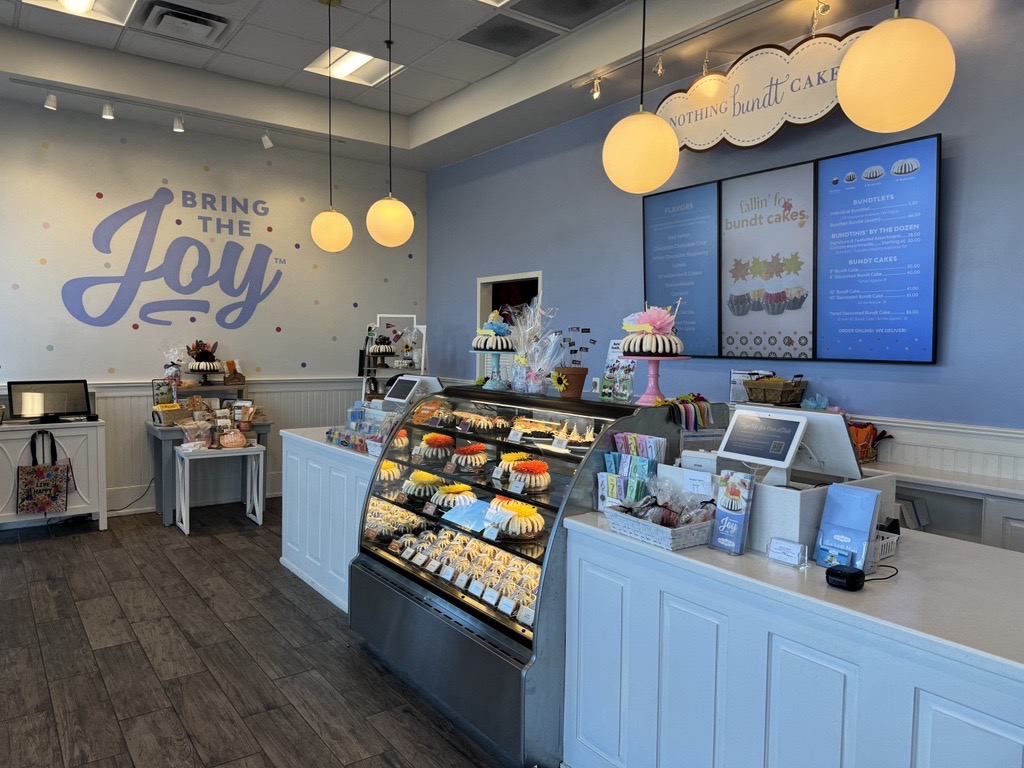“Every job requires sacrifice,” Dolf Berle says with a smirk. “And, sometimes, really digging into the things that most people wouldn’t want to do. And I have to say that trying all the Nothing Bundt Cake flavors really tested my limits.” Named the CEO last summer of the Addison-based bakery giant—which sells full-sized and mini bundt cakes in flavors ranging from red velvet and lemon to classic vanilla and chocolate chip—Berle was jesting, of course, but he does note that his favorite is the gluten-free chocolate chip. He also wants it to be known that the company is innovating with cream-filled and gluten-free flavors. But new menu items is just the tip of the iceberg.
The former Dave & Buster’s president and COO and Topgolf and adventure travel operator Lindblad Expeditions CEO took over a company with 800 corporate employees, 10,000 total franchise employees, and 535 bakeries in 43 states—a number of which are reporting $3 million in sales per year. By all accounts, the brand is already a wild success. “But I would not only like to be an iconic brand,” he says. “I want Nothing Bundt Cakes to be a phenomenon.”
In the mid-to-late 2010s, Nothing Bundt Cakes used its franchising model to add 40 to 50 bakeries a year. In the spring of 2021, private equity firm Roark Capital Group—which holds around $37 billion in assets, including Subway, Orangetheory Fitness, and Wingstop—purchased the brand, which at the time had 390 bakeries. Since closing the deal, bundt cakes have been selling like—well—hotcakes. In 2023, the brand, which was founded in 1997, opened about 90 storefronts. The year represented an inflection point for the brand’s growth. “In 2024, our growth goal is to open over 150 new bakeries,” Berle says. That would all add up to about an 80 percent increase in bakeries in fewer than three years.
Same-store sales through the ascent are steadily growing. Over the last decade, the average growth rate per year has been 10 percent or higher, according to Berle. “We’re going to try to keep that trajectory going,” he says. The brand’s CFO, Jennifer Ellis, adds, “We’ve never had a negative same-store sales growth quarter in the history of the brand—which is almost 27 years old now.”
Berle’s plans to continue bolstering growth include new digital strategies, marketing approaches under new Chief Marketing Officer Sean Gleason, and opening bakeries in nontraditional venues, including stadiums and arenas across the country. In 2024, Nothing Bundt Cakes will launch a loyalty program through a mobile app and slowly roll out a brand refresh with new interior designs, digital imagery, and color schemes inside bakeries. (The new look is already being tested and refined at venues in Frisco and Plano and the Dallas location off Preston and Royal.) And Nothing Bundt Cakes will soon embark upon an entirely new brand of thematic marketing. “Just like Tiffany & Co.’s blue has become iconic,” Berle says, “we have dreams of our periwinkle blue becoming iconic, as well.”
The Midas Touch

Berle grew up in a farming community in western Massachusetts and was born into a family that worked for various nonprofits. So, he came of age believing his path would wind toward ministry or education. But in the back of his mind, his desire to become an Olympic athlete burned just as bright. “The Olympics was the big dream,” he says. While studying history and literature at Harvard, he was on the track and field team at the Ivy League institution. Unlike his teammates, he didn’t excel at one specific event—he wasn’t the fastest sprinter or the quickest hurdler or the strongest discus thrower. So, he honed his focus on versatility. “I became the fourth-best person on the team at every event,” Berle says with a laugh. But fourth best at everything was good enough to excel in the decathlon—a 10-event race that includes the 100-meter dash, 400-meter dash, 1,500-meter dash, 110-meter hurdles, long jump, high jump, pole vault, discus throw, javelin throw, and shot put.
After graduating from Harvard, he traveled on assignment to Zimbabwe to help find alternatives to divestments, primarily in Black education. While there, he fell in love with the people and culture. After earning his degree, Berle moved to Zimbabwe to pursue a master of arts in African History at the University of Zimbabwe. He excelled athletically for the Crimson but had come to accept that he didn’t have the skills to compete at the highest level and realize his dream of becoming an Olympian. While in Zimbabwe, though, he competed in various track and field events and, despite antiquated equipment, became the first man to pole vault more than four meters on Zimbabwean soil.
For the next 14 years after he left Zimbabwe, Berle put his track and field talent on the shelf. He moved to Dallas and worked for Waste Management, Yum! Brands, and PepsiCo. In 1998, he earned his first C-Suite position as chief operating officer of Diedrich Coffee. Two years later, he was named COO of House of Blues Entertainment. Around the same time, he met an older man in a gym wearing a pole-vaulting T-shirt. Berle asked him, “Were you a pole vaulter?” The man replied, “I am a pole vaulter.” Berle was inspired to rekindle his participation in the sport and began training with a program called World Master’s Athletics, targeted at track-and-field athletes aged 35 and older. In doing so, he rediscovered the joy he left behind in Zimbabwe many years ago.

When Berle turned 40, he entered the WMA World Masters Championships with a goal of finishing in the top 10 in the decathlon and pole vault. “I came in second in the pole vault and fourth in the decathlon, which exceeded my expectations,” he says. “But second and fourth places are the most heart-wrenching places to finish because I was just off being the champion and just off the podium.”
That competition fueled Berle, and it—along with the resilience story of his son Bax (see sidebar)—propelled him to compete in Season 9 and Season 10 of American Ninja Warrior. Berle’s runs were not televised, and he was unable to complete the course, but getting to meet so many competitors with “amazing stories of overcoming obstacles was very inspiring,” he says.
Just like Tiffany & Co.’s blue has become iconic, we have dreams of our periwinkle blue becoming iconic, as well.
Dolfe Berle | CEO, Nothing Bundt Cakes
When he turned 50, Berle won the WMA World Masters Championship in pole vault and came in third in the decathlon. Fast forward to 2023, he traveled to Poland to compete in the same event for pole vault, this time in the 60–64 age group. The exec took home the gold for pole vaulting. Several months later, he competed in the USA Decathlon Masters Championships and placed first for men aged 60 to 64. Berle not only excelled for a 60-year-old, “but for the first time in my life, I was able to have the highest score for all men of all ages,” he says.
In between competitions, he was quickly rising in the business ranks. In 2006, he was named president of Lucky Strikes Lanes. Three years later, he joined ClubCorp as its executive vice president of hospitality and division head. In 2011, Dave & Buster’s—coming off its $570 million acquisition by Oak Hill Capital Partners—hired him as president and COO to manage store operations, the brand’s P&L, and all company assets. “I was one of the people brought on by that new wave of ownership to reposition the business to be more modern and contemporary and accelerate the growth,” Berle says.
The brand freshened up its venues by introducing big-screen televisions and making things more “Vegas-like,” says Berle. By 2014, Dave & Buster’s was ready for an IPO. “In the six-plus years I was there, we built nearly 50 units and quadrupled the value of the business,” he says. “I was proud of the fact that I was at every single opening over the course of those years, and we were hiring a few thousand people a year in order to staff the new stores.”
In 2014, the company listed on the NASDAQ at a value of $625.4 million. By the end of 2016, Dave & Buster’s had grown its revenue to more than $1 billion, and Berle decided to leave for a new challenge. He spent 2017 independently advising nonprofits and serving on various company boards. The following year, 2018, Topgolf came calling, looking for a new CEO to lead it through its formative years. The company took off like a bullet.
“We more than doubled the number of units, building more than 10 units a year and hiring more than 4,000 people a year,” Berle says. Revenue grew from $630 million at the close of 2017 to $1.2 billion in 2021—the year he stepped away. In the midst of it all, Berle was tasked with a resurrection.
In 2019, leading into 2020, he was at the forefront of Topgolf’s efforts to become a publicly traded company. After all, full-year 2019 saw Topgolf report $1.06 billion in revenue and an adjusted EBITDA of $59 million, according to SEC documents. But the pandemic in March of 2020 halted Berle’s efforts. “We were three weeks away from going public,” he says. “We had already completed analyst day and had done everything short of the roadshow on pricing. We went from a high-growth company with tremendous momentum to a mode where we had to save the company. The worst day of my business life was furloughing 19,000 employees, many of whom were living paycheck to paycheck.”
So, Berle and other Topgolf executives and board members went to work on alternatives. Callaway Golf emerged as a buyer, and the company jumped at the opportunity. “On the path to going public, the valuations that we were seeing were ultimately higher than what Callaway paid,” Berle admits. “But I think we all felt it was a fair price at the time it was sold, given the pandemic’s influence and the uncertainty, quite frankly, about when we would reopen.”
For Berle, who stayed on several months after the sale to help transition the company, working for one of the world’s largest golf companies was not a personal fit. “My individual preference was to be part of a standalone company where I could be the CEO of that, as opposed to the leader of a division,” he says. “That’s what prompted my exit.”
Dolf has made his career in the joy, entertainment, and fun business, so he fits right in.
Jennifer Ellis | CFO, Nothing Bundt Cakes
He walked away in 2021 and joined New York-based public adventure travel operator Lindblad Expeditions, which had also suffered through the pandemic. After an $82 million 2020, Berle grew its 2021 revenue to $147 million and closed 2022 at $421.5 million. Halfway through 2023, Berle shifted to Nothing Bundt Cakes. His fellow C-Suiters say he has been the icing on the cake for the brand. “Dolf has made his career in the joy, entertainment, and fun business, so he fits right in,” says CFO Ellis.
Stepping on the Gas
According to the American Bakers Association, the industry contributes an overall economic impact of more than $186 billion to the U.S. economy each year. Nothing Bundt Cakes is just a small part of that, but Berle’s top priority as he enters 2024 is filling the brand’s whitespace. “We know that roughly 30 percent of America knows about us, and 70 percent has neither tasted a cake nor heard of what we offer,” he says. So, opportunity abounds.
It starts, of course, with finding franchisees—and the pipeline has never been more primed. “At the moment, we have more than 200 sites signed up for future developments, and that’s growing every week,” Berle says. “We’re building four to five bakeries per week.” And new store operators are reporting record inaugural years. “Our annual unit volume for a store’s first year has gone up more than $200,000 versus where it was two years ago,” Berle says. “We’ve been setting revenue records every year for the last few years. So, each year, the goalposts move, and 2023 will track with that,” says Ellis.
At the forefront of Nothing Bundt Cakes’ real estate approach is Chris Tarrant, former Starbucks senior vice president of store development for the U.S. and Canada. He was responsible for opening 1,200 new Starbucks and renovating about 800 locations a year. Now, as the chief development officer for Nothing Bundt Cakes, he’s implementing a real estate strategy to find new markets, whereas Starbucks’ real estate strategy has shifted to infill areas.
“We’re taking a broad co-tenancy look at where we would ideally locate,” Tarrant says. “We look at weekly trip generators like grocery stores, pharmacies, and things like that, as well as daily trip generators like Starbucks. Obviously, that data helps give us an idea about daily traffic, but we’re trying to be respectful to the guests and convenient for them because you don’t want to ever put too much pressure on a brand to draw guests in just by itself. Everyone’s in a time compression today, and the better we get at accessibility and overall co-tenancy, the more successful we are.”

Bakeries can get up and running at a $35,000 franchising fee and roughly $700,000 in construction costs. A top Texas and Oklahoma Nothing Bundt Cake’s franchisee Jim Sheahan—who was awarded Franchisee of the Year by the International Franchise Association—says his latest bakeries are rapidly turning a profit.
“Our Norman, Oklahoma, store that we opened in February 2022 set the record for a Nothing Bundt Cakes,” he says. “Historically, stores plodded along for a little bit, but now the brand has dedicated more marketing to store openings, and we come out of the gates swinging.”
Spurred by new owner Roark Capital, 2023 was the first full year for the brand to leverage third-party delivery channels DoorDash, Grubhub, and Uber Eats. “We were hesitant given the type of product we present,” Ellis says. “Our cakes are a little more delicate than traditional food; we certainly don’t want them to show up upside down or the frosting or decoration is not how they should be. So, we tapped into Roark’s expertise and network to help us understand and grasp the ins and outs of third-party delivery channels. It has been performing phenomenally for us and allowed us to capture new guests.”
The same momentum is expected to spark once Nothing Bundt Cakes launches its loyalty program through a mobile app. “The brand hasn’t been in a place technologically to execute it yet,” says franchisee Sheahan, who employs 300 people across nine stores in Texas and Oklahoma. “But now, this will prop up our business and take it to the next level.”
Sheahan has two more bakeries under construction and seven more in the pipeline. Over the next four to eight months, he expects his employee base to grow to 500. “Dolf brings experience, passion, and energy,” Sheahan says. “I feel confident where we can go and know that Dolf can take us from the 500-store mark to more than 1,000—and that’s one of the many reasons I’m stepping on the gas.”
Berle has spent no more than seven years at any of the prior enterprises he has led. He says his sweet spot is taking the helm post-founder at businesses generating between $400 million and $600 million in revenue with a desire to double in size. Nothing Bundt Cakes is no different, and Berle is as confident as ever that he can deliver the returns. “My experience is really around helping good companies mature and reach heights that otherwise would have been quite difficult,” he says.
And if there’s one thing the champion decathlete and pole vaulter has proven through the years, in both sports and business, it’s that he can achieve the difficult. At Nothing Bundt Cakes, he’s not too far off the starting line, and the race ahead will be a long one. “I hope this is my last job of this nature,” he says, “because there is plenty to work with over the course of the next 10 years.”
Author









